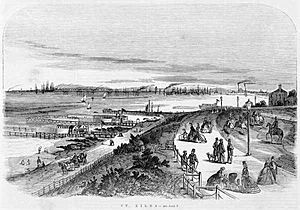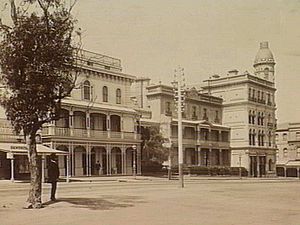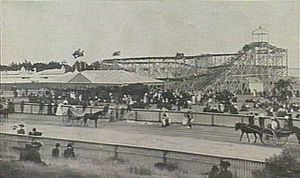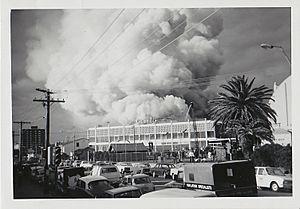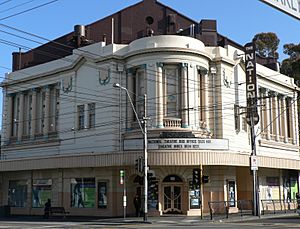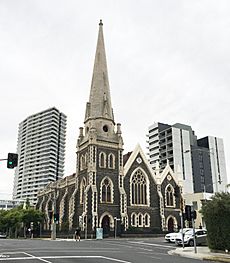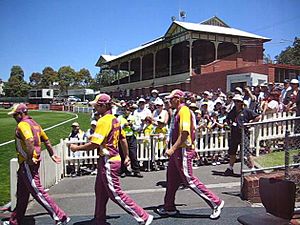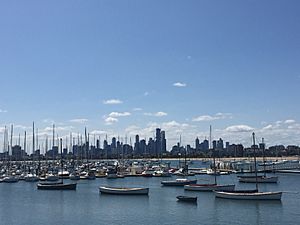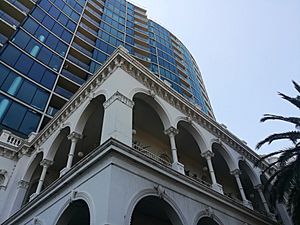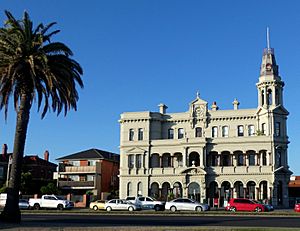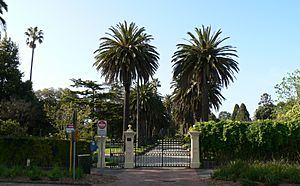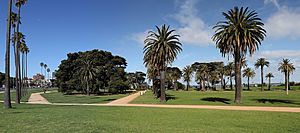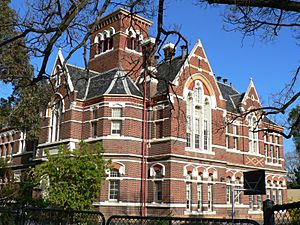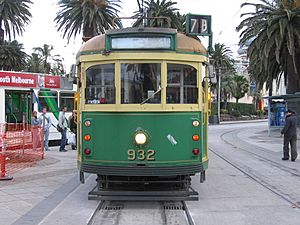St Kilda, Victoria facts for kids
Quick facts for kids St KildaMelbourne, Victoria |
|||||||||||||||
|---|---|---|---|---|---|---|---|---|---|---|---|---|---|---|---|
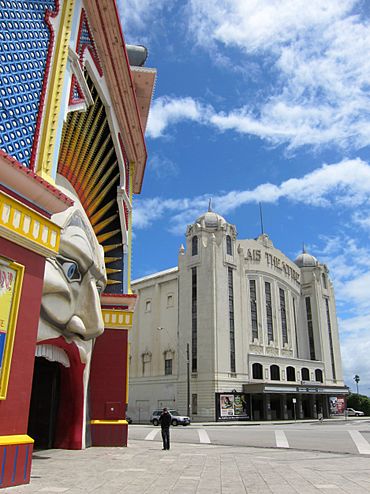
Luna Park and the Palais Theatre on the St Kilda foreshore
|
|||||||||||||||
| Population | 20,230 (2016 census) | ||||||||||||||
| • Density | 6,320/km2 (16,400/sq mi) | ||||||||||||||
| Established | 1839 | ||||||||||||||
| Postcode(s) | 3182 | ||||||||||||||
| Area | 3.2 km2 (1.2 sq mi) | ||||||||||||||
| Location | 6 km (4 mi) from Melbourne CBD | ||||||||||||||
| LGA(s) | City of Port Phillip | ||||||||||||||
| State electorate(s) |
|
||||||||||||||
| Federal Division(s) | Macnamara | ||||||||||||||
|
|||||||||||||||
St Kilda is a lively seaside suburb in Melbourne, Victoria, Australia. It is located about 6 kilometers (3.7 miles) south-east of Melbourne's city center. The local government area for St Kilda is the City of Port Phillip. In 2016, about 20,230 people lived in St Kilda.
Charles La Trobe, who was in charge of the Port Phillip District, named St Kilda in 1841. He named it after a schooner called Lady of St Kilda. This ship was often anchored at the main beach in 1841. During the Victorian era, St Kilda became a popular place for Melbourne's rich families. Many large houses and grand buildings were built along its hills and waterfront.
After the early 1900s, the St Kilda foreshore became a favorite fun spot for Melbourne. Electric trams connected suburbs to amusement rides, dance halls, cinemas, and cafes. Crowds loved visiting St Kilda Beach. Many big houses became guest houses. Apartment buildings filled in gardens, making St Kilda a very busy suburb.
After World War II, many guest houses became affordable places to live. By the late 1960s, St Kilda was known for its artistic and free-spirited culture. It attracted many artists and musicians. Since the 2000s, St Kilda has changed a lot. It has become more popular with wealthier people.
St Kilda has many famous places to visit. These include Luna Park, St Kilda Pier, the Palais Theatre, and the Esplanade Hotel. It also hosts many of Melbourne's big events and festivals.
Contents
What's in a Name? St Kilda's Story
Before its official name in 1841, the area had other names. These included 'Green Knoll' and 'Punk Town'. Charles La Trobe, who was the superintendent of the Port Phillip District, officially named it St Kilda.
The name came from a ship called the Lady of St Kilda. This schooner was owned by Sir Thomas Acland. In 1841, the ship sailed to Melbourne. It was used to carry cargo. For most of that year, the ship was anchored at the main beach. This area soon became known as "the St Kilda foreshore."
The schooner Lady of St Kilda was named after Rachel Chiesley, Lady Grange. She was held captive on Hirta island. Hirta is the largest island in the St Kilda archipelago in Scotland.
St Kilda's Past: A Journey Through Time
The area now known as St Kilda was first lived in a very long time ago. People lived here about 31,000 to 40,000 years ago. Signs of their life include shell piles and huts near Albert Park and Lake. Axes sharpened on the cliffs behind the beach have also been found.
Traditional ceremonies, called Corroborees, were held at a historic tree. This tree still stands at St Kilda Junction. Much of the area north of Fitzroy Street used to be swampland. It was part of the Yarra River delta, with many wetlands.
The first European settler in St Kilda was Benjamin Baxter around 1839. He was a farmer from Melbourne. In 1840, St Kilda had Melbourne's first quarantine station for Scottish immigrants.
The area was officially named St Kilda in 1841. The first land sales happened on December 7, 1842. James Ross Lawrence bought the first block. He had been the master of the Lady of St Kilda. He named one road Acland Street, after his former employer. The other two roads became Fitzroy Street and The Esplanade.
Within a few years, St Kilda became a popular place for wealthy people. The high ground above the beach offered cool breezes in summer. St Kilda became its own town on April 24, 1857. In the same year, a railway line connected St Kilda to Melbourne city. This made the area even more attractive. People visited St Kilda Beach, the St Kilda Pier, and the St Kilda Sea Baths.
Cricket and bowling clubs started in 1855 and 1865. By the mid-1860s, St Kilda had about fifteen hotels. The George Hotel, which started as the Terminus, opened in 1857.
The Building Boom of the 1880s

St Kilda's population more than doubled between 1870 and 1890, reaching about 19,000 people. By the 1880s, St Kilda was full of grand mansions. There were large villas with big gardens, impressive terraces, and fancy hotels. These were especially along main streets like Fitzroy Street, Grey Street, and Acland Street.
The area known as St Kilda Hill also had many mansions. The Esplanade Hotel was built in 1878, looking over St Kilda Beach. The George Hotel was greatly expanded in 1889. Smaller streets had more modest homes for working-class people.
Cable tram lines were built in the late 1880s. A line from central Melbourne to St Kilda Junction opened in 1888. Another line opened in 1891, making the suburb and beach easily reachable.
St Kilda: Melbourne's Seaside Playground
The building boom ended with financial problems in the early 1890s. Many of St Kilda's mansions became guest houses. Wealthy families moved to other suburbs like Brighton and Toorak.
From 1906, electric tram lines brought many day-trippers to the beach. By 1913, two lines ended in front of Luna Park. Carlo Catani, a local resident and engineer, helped design the beautiful St Kilda foreshore. His plan created parks, paths, gardens, and tree-lined avenues.
The foreshore committee also managed amusement park leases. These included Dreamland (1906), a new St Kilda Sea Baths (1910), Luna Park (1912), and the Palais Theatre (1927).
Acland Street and Fitzroy Street became busy with shops, restaurants, and cafes. Many apartments were built, making St Kilda the most densely populated suburb in Melbourne. This attracted single people moving away from family life.
St Kilda was also a favorite place for Melbourne's Jewish community. This continued through the years between the World Wars. Many refugees from Europe settled here after WW2. Acland Street gained a European feel with many cake shops and delicatessens. Cafe Scheherazade, famous for its food, was an icon for this community. Today, the famous cake shops on Acland Street remind us of this history.
Changes and Modern Times
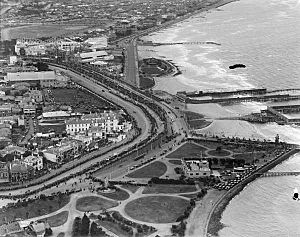
After World War II, St Kilda's beach attractions were very popular. Leo's Spaghetti bar, one of Melbourne's first Italian restaurants, opened for the 1956 Olympics.
In the early 1960s, the Lower Esplanade became a fast road. This created a barrier to the beach. In 1968, the Palais de Danse, next to the Palais Theatre, burned down. The Palace nightclub was built in its place in 1971.
In the late 1960s, St Kilda Junction was rebuilt. This changed the area's layout. In the early 1970s, St Kilda Road was widened. Many buildings were demolished, including the landmark Junction Hotel. This made High Street, once a shopping center, less important.
The St Moritz ice rink closed in 1981 and was destroyed by fire around 1982.
St Kilda's Modern Comeback
In 1987, the St Kilda railway line became part of tram route 96. This was one of Melbourne's first light rail lines.
St Kilda also became more popular with young professionals in the 1990s. This was because it was close to the city center. Rising rental costs caused many long-term residents to move away.
In 1991, the former St Moritz ice rink site reopened as the St Moritz hotel. It later became the Novotel St Kilda.
In 2003, the 99-year-old pier kiosk burned down. The government quickly decided to rebuild it using original plans.
For the 2006 Commonwealth Games, St Kilda hosted a public artwork. It was a timber sculpture of the Lady of St Kilda shipwreck. It was popular but later removed for safety reasons.
The area near the Palais Theatre, called the Triangle Site, has been redeveloped. The Palais Theatre was restored. In 2007, plans for new eating areas, art spaces, and walkways were approved.
In 2006, plans for a skate park on Fitzroy Street caused controversy. Many local people objected. In 2008, the Supreme Court stopped the skate park development.
In 2009, a new council ended the agreement with the developers for the Triangle site. They agreed to pay $5 million. In January 2020, the average house price for a three-bedroom house in St Kilda was A$1.34 million.
Who Lives in St Kilda?
| Historical population | ||
|---|---|---|
| Year | Pop. | ±% |
| 2001 | 15,270 | — |
| 2006 | 16,122 | +5.6% |
| 2011 | 17,795 | +10.4% |
| 2016 | 20,230 | +13.7% |
In the 2016 Census, St Kilda had 20,230 people. About 51.3% were born in Australia. Other common birthplaces included England (5.2%), New Zealand (3.8%), and India (2.1%). Most people (66.2%) spoke only English at home.
St Kilda is a place of big differences. Many people with lower incomes live alongside wealthy residents. The suburb is known for its many backpackers and also for its long-term residents.
For many years, St Kilda has had the highest population density in Melbourne. This means many people live in a small area. Most homes are apartments and flats.
St Kilda is a very multicultural community. There are restaurants and shops from many cultures. These include Italian, Japanese, Chinese, Indian, French, and Thai. The Jewish community has become smaller, but many synagogues still operate. The Jewish Museum of Australia is on Alma Road.
An Italian Australian community has been in St Kilda for over a century. A growing French community has also settled here. The Alliance Francaise de Melbourne is located in St Kilda. There is also a small community from the former Soviet Union. St Kilda also has one of Melbourne's larger Indigenous Australian communities.
St Kilda's Culture: Arts, Events, and Music
Theatre and Cinema in St Kilda
St Kilda has three main theaters, each with a different purpose. All are listed on the Victorian Heritage Register. The National Theatre on Barkly and Carlisle Streets was built in 1920. It is home to Australia's oldest ballet school.
The Palais Theatre on the Esplanade was built in 1927 as a cinema. It is now used for live music and concerts. The Astor Theatre on Chapel Street was built in 1935. It has the largest screen in the Southern Hemisphere. It shows art-house films and hosts its own film festival.
Places of Worship in St Kilda
St Kilda has many places of worship. Most were built for Christian and Jewish faiths. The St Kilda Hebrew Congregation was built between 1872 and 1880. The current building was opened in 1927.
The former Baptist Church (1876) is now part of St Michael's Grammar School. The St Kilda Presbyterian Church (1878) was designed by Wilson & Beswicke. The Sacred Heart Church (1890) is a St Kilda landmark with its tall tower. All Saints' Anglican Church (1858) is believed to be the largest Anglican parish church in the Southern Hemisphere.
Events and Festivals in St Kilda
St Kilda hosts many big annual events. The largest is the St Kilda Festival. It is Australia's biggest free music festival. This one-day event has live music, dance, carnival rides, and food stalls. Over half a million people visit each year.
St Kilda also hosts the annual gay Pride March. It starts at Lakeside Drive and goes down Fitzroy Street. The St Kilda Short Film Festival is Australia's longest-running short film festival. It has shown Australian short films since 1983.
Other local events include the St Kilda Film Festival and St Kilda Writers Festival. St Kilda even has its own TEDx event, TEDxStKilda. St Kilda has also run Melbourne's first major arts and crafts market. It has been held on the Esplanade every Sunday since the 1980s.
Music Scene in St Kilda
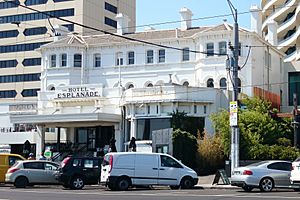
St Kilda has a lively music scene. Many famous bands and artists started here. In the late 1970s, it was a hub for post-punk music. Bands like The Birthday Party (with Nick Cave) played at the Crystal Ballroom.
Other artists like Paul Kelly and Tex Perkins have lived in St Kilda. Popular music venues include the Palais Theatre for big concerts. The Esplanade Hotel (known as "The Espy") and the Prince of Wales Hotel are also well-known. Men at Work started in St Kilda.
Sports in St Kilda
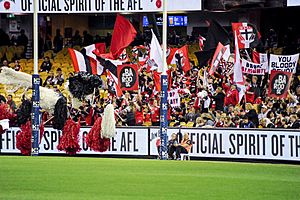
St Kilda has strong ties to Australian rules football. The St Kilda Football Club, called the Saints, formed in 1873. They play in the national Australian Football League (AFL). Their original home was Junction Oval.
The St Kilda City Football Club plays at the Peanut Farm. St Kilda also has a Women's Australian rules football team, the St Kilda Sharks. Albert Park and Lake has several ovals for Australian rules football clubs.
St Kilda also has a strong cricket presence. The Junction Oval is home to the St Kilda Cricket Club. It was also where Shane Warne made his debut. St Kilda has other sports too, like field hockey, baseball, and soccer.
The St Kilda Lawn Bowls Club on Fitzroy Street has a long history. It is popular and has been featured in movies and TV shows.
St Kilda beach hosted many water events for the 2007 World Aquatics Championships. The 2006 Commonwealth Games triathlon and cycling events were held along the foreshore. The annual Melbourne Marathon also passes through St Kilda. St Kilda Beach is often used for beach volleyball tournaments.
Fun and Relaxation in St Kilda
You can do many watersports at St Kilda West and Middle Park beaches. These include windsurfing, sailing, kitesurfing, rollerblading, and beach volleyball. You can also go diving, jetskiing, or waterskiing. Skydiving is also available. There is a skate park on Marine Parade.

St Kilda's Buildings and Green Spaces
Famous Local Landmarks

St Kilda has many unique landmarks, mostly around the Esplanade and foreshore. Many have a Moorish style with domes. The most famous is Luna Park, an old amusement park. It has a "Moonface" entry and a historic scenic railway.
The St Kilda Pier is another landmark and tourist spot. At the end of the pier is the St Kilda Pavilion. This Edwardian building is very important to Melbourne. It was rebuilt after burning down. The pier's breakwater protects St Kilda Harbour and is home to a little penguin colony.
St Kilda Beach has gentle waves and is popular for swimming and sunbathing.
The St Kilda Sea Baths was a Moorish-themed building. It was rebuilt in the 1990s to look like the original style. It continues a history of sea baths in St Kilda dating back to the 1850s.
Acland Street is a shopping and restaurant area. It has many cake shops and cafes. It is now a dead-end street with a tram stop.
St Kilda Town Hall was designed by William Pitt. It burned down in the 1980s and was rebuilt inside. Across the street is the St Kilda Public Library. It was built in 1971-1973 in a brutalist style.
Homes and Buildings
St Kilda has a mix of building styles. These include Victorian terrace houses, Edwardian homes, and modern apartments. Many of St Kilda's buildings are nationally recognized.
St Kilda has many "boom style" mansions from its early days. Eildon Mansion (1855) on Grey Street is a grand old mansion. Hewison House (1869) is a former mansion now used by St Michael's Grammar School. Marion Terrace (1883) is one of Australia's best Second Empire-style terrace houses. Myrnong Hall (1890) is a large Victorian mansion.
Edwardian buildings include The Priory (1890) on Alma Road. It is one of Melbourne's few Richardsonian Romanesque homes.
In the years between the World Wars, St Kilda was divided into many apartments. This led to some great early apartment designs. These include Majestic Mansions (1912) and Summerland Mansions (1920) on Fitzroy Street. Belmont Flats (1923) on Alma Road is a mix of Arts and Crafts and Californian Bungalow styles. Belvedere Flats (1929) on the Esplanade is a Spanish Mission-style building.
Edgewater Towers, built in 1961, was Melbourne's first private high-rise apartment building. St Kilda also has modern residential designs. St Leonards Apartments (1996) are two blocks of post-modern apartments.
Historic Hotels
St Kilda has many grand old hotels. Some still operate as pubs, and others are now accommodation. Most are listed on the Victorian Heritage Register. The Esplanade Hotel (1878) is a famous pub and music venue. Locals call it 'The Espy'.
The St Kilda Coffee Palace (1870s) was once the main coffee palace. It is now a hostel. The George Hotel (1887) is on Fitzroy and Grey streets. From 1979 to the mid-1980s, its "Crystal Ballroom" was a punk music venue. It launched artists like Nick Cave. In the 1990s, it became studio apartments.
The Prince of Wales Hotel was built in 1940. It is now another live music venue.
Parks and Gardens
St Kilda is known for its many parks and gardens. They often feature Canary Island date palms and Californian fan palms. The St Kilda Botanic Gardens on Blessington Street has heritage features, a conservatory, and a rose garden.
The St Kilda Foreshore and Catani Arch are on Jacka Boulevard. The upper Esplanade reserve hosts the Sunday markets. It has the Catani Clock Tower. The Catani Gardens include a War Memorial and a Captain Cook statue.
O'Donnell Gardens is next to Luna Park. Alfred Square on the upper Esplanade has war memorials. Albert Park is a large park that includes part of St Kilda. It has sports fields and a lake. The St Kilda Town Hall has a small Victorian garden.
St Kilda is home to one of Melbourne's few remaining Indigenous Australian landmarks, the Corroboree Tree. This red gum eucalyptus is between 400 and 700 years old. It is near Queens Road and Fitzroy Street. A plaque says that Aboriginal people held ceremonies under this tree. These ceremonies celebrated events, told stories, and brought communities together.
The "Veg Out" Community Gardens are at the former St Kilda Bowling Club. Residents can rent plots to grow plants and create colorful displays.
Schools in St Kilda
St Kilda has several schools. These include secondary schools like St Michael's Grammar School and Christian Brothers College. Primary schools include St Kilda Primary School and St Kilda Park Primary School. All have impressive old buildings.
St Kilda in Pop Culture
St Kilda has been featured in many TV shows and songs. The Network Ten drama The Secret Life Of Us (2001-2005) was set in St Kilda. It showed characters playing soccer in Catani Gardens and lawn bowls at St Kilda bowls club.
Many of Paul Kelly's songs mention St Kilda. His song "From St Kilda to Kings Cross" talks about the St Kilda Esplanade. Other songs like "Killed her in St Kilda" by Voodoo Lovecats also feature the area.
Many movies and video clips have been filmed in St Kilda. These include scenes from The Story of the Kelly Gang. Beach scenes from the 2005 Bollywood film Salaam Namaste were filmed here. The 2006 film Kenny also features the St Kilda Festival.
Australian rock band Hunters & Collectors filmed many video clips in St Kilda in the 1980s. These include "Talking to a Stranger" at the old St Kilda railway station.
The fictional detective Phryne Fisher from author Kerry Greenwood's novels lives in St Kilda. Her stories were made into the TV series Miss Fisher's Murder Mysteries.
The suburb of Saint Kilda in Dunedin, New Zealand, was named after Melbourne's St Kilda.
Getting Around St Kilda
St Kilda is well connected to Melbourne's city center by trams. A special light rail line runs along the old St Kilda railway.
Tram routes 3a (weekends), 12, 16, and 96 serve St Kilda. All routes take about 25 minutes from the city.
St Kilda also has water transport. Williamstown Ferries runs a regular ferry service between St Kilda and Williamstown. The Royal Melbourne Yacht Squadron has a building at St Kilda harbour. It also runs the St Kilda Marina.
The Bayside Trail is a bike path that goes through St Kilda. There is also a bike lane along Fitzroy Street.
Famous People from St Kilda
Many notable people have lived in St Kilda.
- Visual artists
- Rupert Bunny (born in St Kilda in 1864)
- Sidney Nolan (lived here between 1917 and 1931)
- Albert Tucker (lived here between 1944 and 1946)
- Mirka Mora (lived here in the mid-1960s)
- Architects
- William Pitt (lived here from 1855-1880s)
- John James Clark (died here in 1915)
- Musicians
- AC/DC (lived here from 1973–1975)
- Mark Seymour (lived here from the 1970s–2005)
- Nick Cave (lived here in the 1970s)
- Paul Kelly (lived here at some point)
- Fred Negro
- Renee Geyer
- Briggs (lived here in the early 2000s)
- Entertainers
- Margot Robbie - actress
- Rachel Griffiths - actress
- Magda Szubanski - comedian
- John Safran - media personality
- Chris Lilley - actor and musician
- Politicians
- Stanley Bruce - a former Prime Minister of Australia (born here in 1883)
- Albert Jacka VC - a brave Army officer and former Mayor of St Kilda
- Writers
- Morris West - author of The Devil's Advocate
- Louis Lavater - poet who lived his whole life in St Kilda (1867-1953)
- Sportspeople
- Michael Klim - swimmer
- Ron Barassi - Australian rules football legend (lived here from the late 1970s)
- Sir Hubert Opperman "Oppy" - famous cyclist (lived at Edgewater Towers from 1961)
Images for kids



